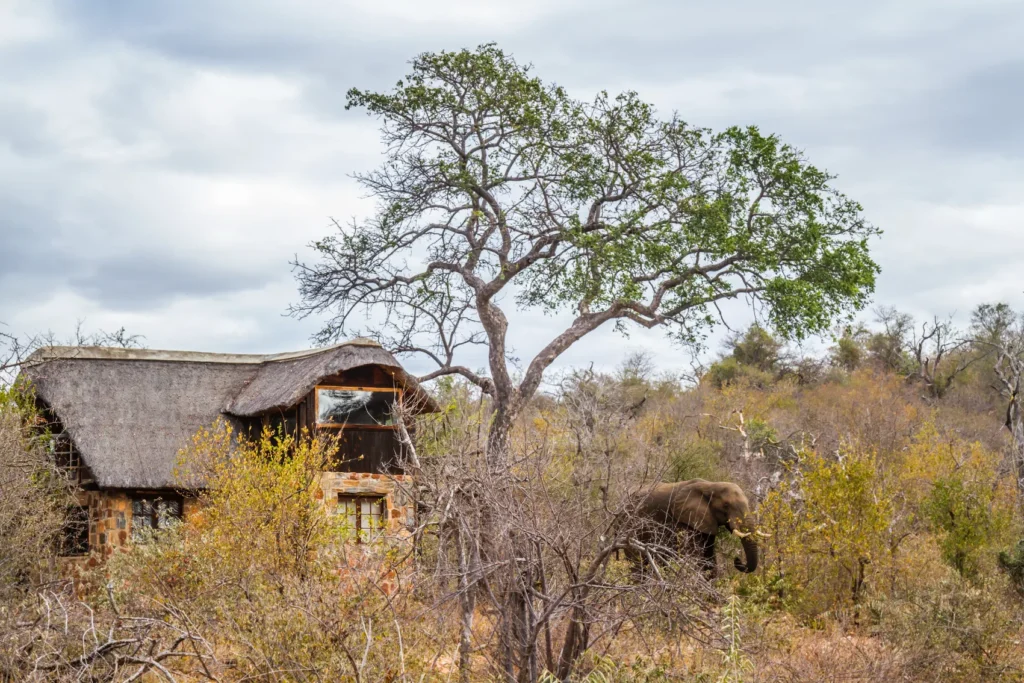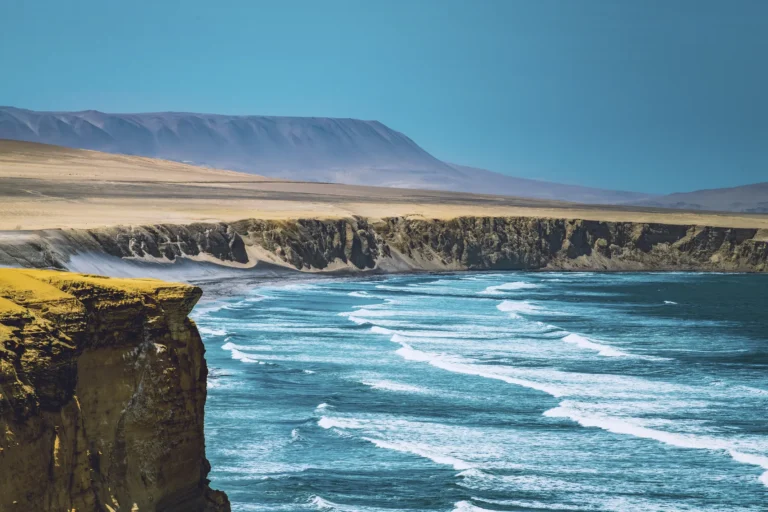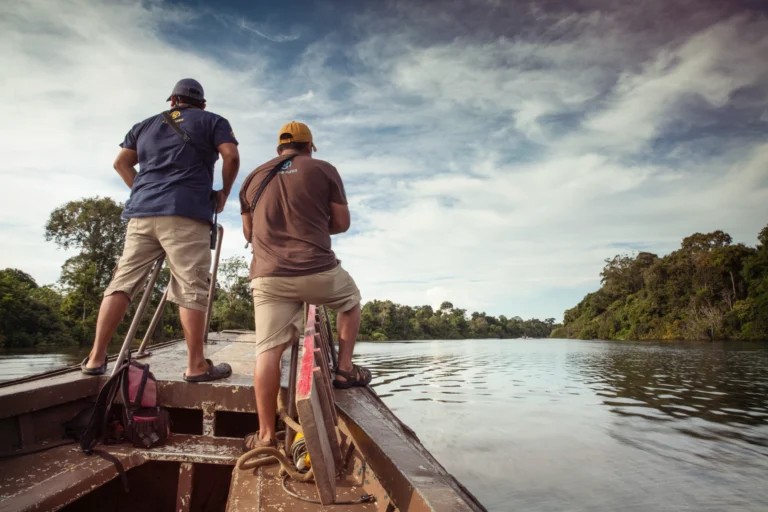
Take a walk on the wild side in South Africa. Home to majestic wildlife, South Africa’s vast savanna is an unforgettable sight, and Kruger National Park is one of the world’s most incredible bucket-list destinations for a South Africa safari. Within its vast plains, elephants wander, giraffes nibble on acacia trees, hippos wallow in the rivers, leopards prowl through the night, and a multitude of birds sing.
Whether it’s dawn or dusk, set out on an exciting safari drive in an open-top Jeep for the chance to spot lions, elephants, rhinos, leopards, and buffalo in their natural habitat. When you aren’t exploring the vast landscapes, hunker down in a remote campsite or a luxurious safari lodge for an authentic back-to-nature stay and a traditional South African braai. Ready to plan the trip of a lifetime? Here are some top tips for getting the most out of your experience in Kruger National Park.
Planning your trip to Kruger National Park
The main thing to remember when visiting Kruger National Park is its sheer size. It covers 19,683 sq km (7,600 sq mi), so it’s important to be realistic about how much of the park you can see. How long to stay in Kruger National Park depends on your budget and desired level of wildlife encounters. While a two-day safari offers a taste of the park’s highlights, a three- or four-day safari provides a more immersive experience, increasing your chances of spotting elusive animals. For dedicated wildlife enthusiasts, a five- to eight-day safari is recommended to explore the park’s diverse ecosystems in depth and provides enough time to switch between self-drive and guided-drive experiences.
Experience it for yourself on: Kruger in Depth
Best time to visit Kruger National Park
Just like the best time to visit the rest of South Africa, Kruger National Park is a fantastic place to travel throughout the year. Many visitors come to Kruger during the dry winter months, from May to September. This season is when visibility is best for spotting wildlife in the open.
Experience it for yourself on: Southern Africa Overland Safari
Kruger National Park accommodations
Travellers have plenty of accommodation options both inside and nearby Kruger National Park to choose from. Whether you’re backpacking on a budget or living the life of luxury, Kruger’s accommodations suit all tastes and bank balances. When choosing accommodations in Kruger National Park, consider your budget, the level of luxury you want, the location (some areas offer better game-viewing opportunities than others), and activities, such as safari drives, bush walks, family-friendly trips, and night drives.

Campsites
For the budget-conscious traveller, campsites and rest camps offer a more affordable way to experience Kruger National Park. Find an approved camping area to pitch a tent or park your campervan under the starlit South African sky. Reserve in advance, especially during the dry winter months, and bring a flashlight!
Pros: Affordable and immersive, with the freedom to explore.
Cons: Basic amenities, potential for wildlife encounters (both wanted and unwanted), and limited shops for supplies.
Safari lodges
Safari lodges offer a comfortable and affordable option for those seeking a balance between luxury and price. These lodges provide comfortable rooms and delicious meals.
Pros: Variety of price points and optional guided safari drives.
Cons: Less personalized service and fewer luxury amenities than high-end lodges.
Luxury safari lodges
For those seeking a truly indulgent safari experience, luxury safari lodges are the way to go. These opulent hideaways offer world-class amenities, gourmet dining, and stunning views of the African bush.
Pros: Personalized service, private safari drives, luxurious rooms, premium inclusions, incredible views.
Cons: High price point, but you get what you pay for!
What area of Kruger should I stay in?
Southern Kruger is the most popular section of the park. It has the highest concentration of animals and is the easiest area to access. However, many visitors think Kruger is at its best in the far north. Here, the number of animals is lower, and fewer lodges are available. However, the bush setting is quieter and more rugged, and it feels more authentic, with its rare flora and fauna. It’s also worth saving enough time to explore the Greater Kruger Area and the Karongwe Private Game Reserve.

Experience it for yourself on: Journeys: Explore Kruger National Park
Safari essentials for Kruger National Park
Packing for South Africa, especially if you’re including a visit to Kruger National Park, is exciting, but it’s important to bring the right gear. Here’s what to pack to ensure a comfortable and memorable safari experience.
– Lightweight, breathable clothing in neutral colours (khaki, beige, or olive green)
– Comfortable, sturdy walking shoes
– Flashlight: nights get exceptionally dark thanks to the lack of light pollution
– Map: download or pack a Kruger National Park map, especially if you’re self-driving
– High-SPF sunscreen
– Insect repellent
– Binoculars: a must-have for wildlife viewing
– Camera
– Reusable water bottle
– Power bank to keep your phone and camera charged on the move
How do you get to Kruger National Park?
The easiest way to reach Kruger National Park by plane is to fly to Johannesburg International Airport (JNB). From there, you can take a domestic flight to Nelspruit, which is closer to Kruger. You can also complete the second leg of this trip via shuttle or rental car. Booking a rental car offers flexibility and freedom to explore the park at your own pace on a self-driving tour.
Other options include a shuttle service that can drive you from the airport to your accommodations. Once you reach the park, you can book seats on guided safari drives. From Johannesburg Airport, the journey takes about four to five hours by car and about an hour from Nelspruit Airport.

Do you need vaccinations for Kruger?
Talk to a doctor or a travel clinic to find out which vaccinations you may need for your trip. Common vaccinations recommended for travellers to South Africa, including Kruger National Park, include hepatitis A, typhoid, and malaria.
Are there entry fees for Kruger?
If you book an organized safari drive with official SANparks rangers, the cost of your drive includes your entry fee. If you decide to go on a self-drive safari or book with an independent company, you need to pay the entrance fee. You can pay these fees at the hut by the entrance gate.
Types of safaris in Kruger National Park
The first thing to do is decide on what kind of safari you’d like to experience. Plenty of safari drive options are available for all budgets.
Self-drive safari: Rent a vehicle and explore the park at your own pace. Self-driving offers flexibility but requires careful planning and solid driving skills.
Guided safari: Joining a guided tour with a knowledgeable ranger is a great way to learn about the park’s wildlife and ecosystems. You can book these at your lodge accommodations, with an independent company, or with official SANParks rangers.
Luxury safari lodge drives: Indulge in a luxurious safari experience with private safari drives, gourmet meals, cocktail sundowners, and stunning lodgings. These lodge-organized outings usually include sunrise and sunset options, as well as nighttime drives.
What wildlife can you see in Kruger?
Kruger National Park is renowned as one of the world’s premier wildlife-watching destinations. With its vast expanse of diverse ecosystems, it’s a haven for a myriad of species.

The “big five” and beyond
The “big five” — lions, leopards, rhinoceroses, elephants, and buffalo — are the most sought-after animals on any African safari, and Kruger National Park offers excellent opportunities to spot all five of these iconic creatures.
Lions are apex predators that rule the savanna, often seen lounging in the shade or stalking their prey. The elusive leopard is a master of camouflage, making sightings a bucket-list experience. Both white rhinos and black rhinos roam the park, and their massive size and distinctive horns make them unforgettable. Majestic elephant herds are a common sight in Kruger. You’ll often find them cooling off in waterholes or foraging for food. Large herds of buffalo, known for their unpredictable nature, can be found grazing on the open plains.
While the “big five” are undoubtedly the stars of the show, Kruger National Park offers much more. Keep an eye out for cheetahs, hyenas, wild dogs, giraffes, zebras, and impalas as well.
Top tips for wildlife-spotting in Kruger
Sunrise and sunset are the prime times for wildlife viewing because animals are most active during these cooler times of day. Binoculars enhance your wildlife-viewing experience, allowing you to spot animals from a distance. A knowledgeable guide can help you spot wildlife and provide valuable insights into their behaviour. Wildlife viewing requires patience. Keep your eyes peeled and be ready to spot animals in unexpected places.
Experience it for yourself on: Best of South Africa






